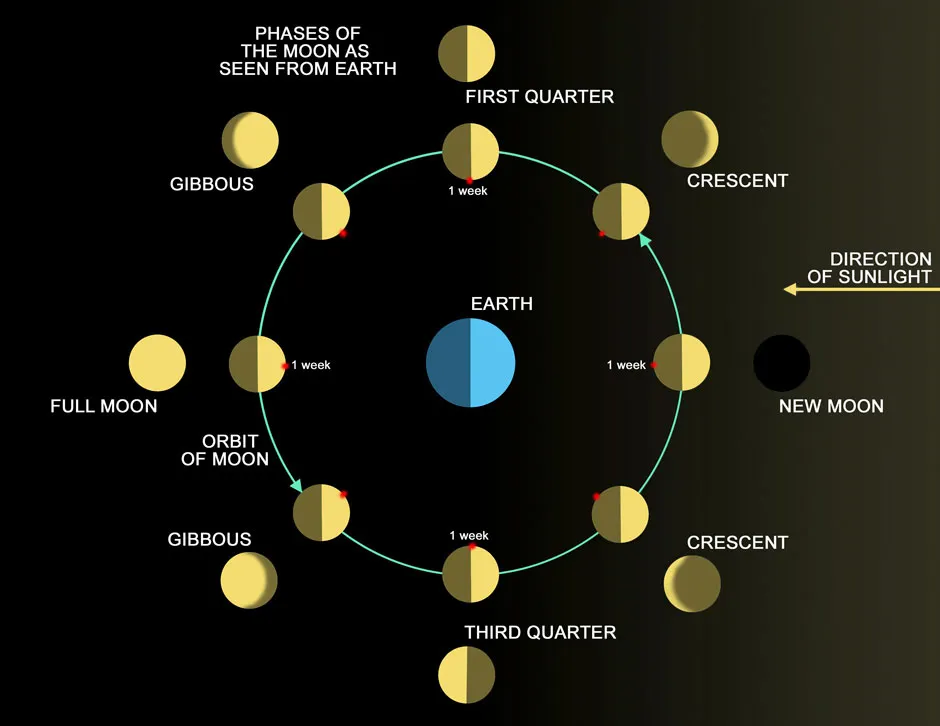And the name of the second full Moon of 2021 is…the Snow Moon. Taking to the night sky in late February 2021, it’s one of 12 full Moons occurring this year.
But when exactly can you see the Snow Moon? Why does it have that name? And, most importantly, how can you take an Instagram-worthy photo of it? Just for you, we’ve answered all those questions and more below.
Plus, if you’re looking for more stargazing tips, be sure to check out our full Moon UK calendar and astronomy for beginners guide.
When is the Snow Moon 2021?
The Snow Moon can be seen from Saturday 27 February 2021 in the UK (and the rest of the world).
To be exact, the Moon will only be ‘full’ – that is, reflecting the maximum amount of sunlight onto Earth – for just a moment. This happens when Earth comes exactly between the Moon and The Sun, a short period of time known as ‘syzygy’.
Weirdly, this syzygy happens during UK daylight hours (8.17am on 27 February). Fortunately, to the naked eye, the Moon will still appear full for another two to three nights afterwards.

Why is it called a Snow Moon?
As per January’s full Moon (the ‘Wolf Moon’), there is no firm agreement exactly where the Snow Moon got its name from.
As Prof Bill Leatherbarrow, director of the British Astronomical Association's Lunar Section says: "There is always uncertainty surrounding popular historical names for full Moons.”
He adds: “The problem is that each month’s full moon seems to have some kind of name attached to it, usually drawn from different cultures. It’s all relative, and there is no scientific rationale or objective authority on which to base the names.”
Read more about the Moon:
However, it’s widely cited that the Snow Moon takes its name from – you won’t believe it – the snowfall common around this time of year in the northern hemisphere.
The Snow Moon is also dubbed the ‘Full Hunger Moon’ across North America. Many believe this originated with snowfall causes difficulties for Native American hunters. However, as Leatherbarrow alludes, there is no definitive source that supports this story.
"Both of those cultural names for February's full Moon makes sense when you consider the climate. It is coldest in January and February, so they are the months when snow is more common and wild food sources are hard to find," saysDr Das Baskill, Physics and Astronomy lecturer at the University of Sussex.
How often are full Moons?
A full Moon happens roughly every 29.5 days, the length of one lunar cycle – around one month (our word for ‘month’ actually comes from ‘Moon’).
The next full Moon, known as the Worm Moon can be seen on Sunday 28 March.

What’s the best way of photographing the Snow Moon?
A quick warning to anyone using their phone to photo the Snow Moon: it’s going to look terrible. Well, terrible unless you use the best settings for night-time photography.
This means turning your flash off, lowering your camera’s ISO sensitivity and setting your focus to 100.
If you’re not sure, you can download one of the many astronomy photography apps. NightCap – available on theApp Store, £2.99 – is our top pick, making it onto our list of best astronomy apps.
For best results on a digital camera, try an aperture of f/11 to f/16 and a shutter speed of between 1/60th and 1/125th of a second. This slow shutter speed means you’ll have to hold the camera extremely steady, or – even better – place it on a tripod.
Reader Q&A: Does the full Moon make people mad?
The origins of this idea date back at least to the Ancient Greeks, with Aristotle 2,300 years ago claiming that the Moon could influence the human mind. But madness wasn’t the only outcome: the original meaning of ‘lunatic’ referred to epilepsy rather than insanity.
The Roman naturalist Pliny the Elder argued that the Moon was able to exert its influence via the water content of the brain – rather like the tides. This is now known to be nonsense: the forces involved are fartoo small.
Even so, the belief persists and has been investigated scientifically many times. A 1985 review of dozens of studies of alleged links between the Moon and everything from psychiatric issues to criminal behaviour found no compelling evidence. But it still remains an active research topic.
Earlier this year, the respected journal BMJ Open published a study claiming to show that a full Moon actually makes murders less likely, although the author admits that the reason isn’t clear, and that other factors may play a role.
So how did the idea of a lunar influence on humans get traction in the first place? One suggestion is that in ancient times a bright full Moon was more likely to disturb sleep – and sleep deprivation is known to exacerbate mood disorders in some people.
Read more about the Moon: